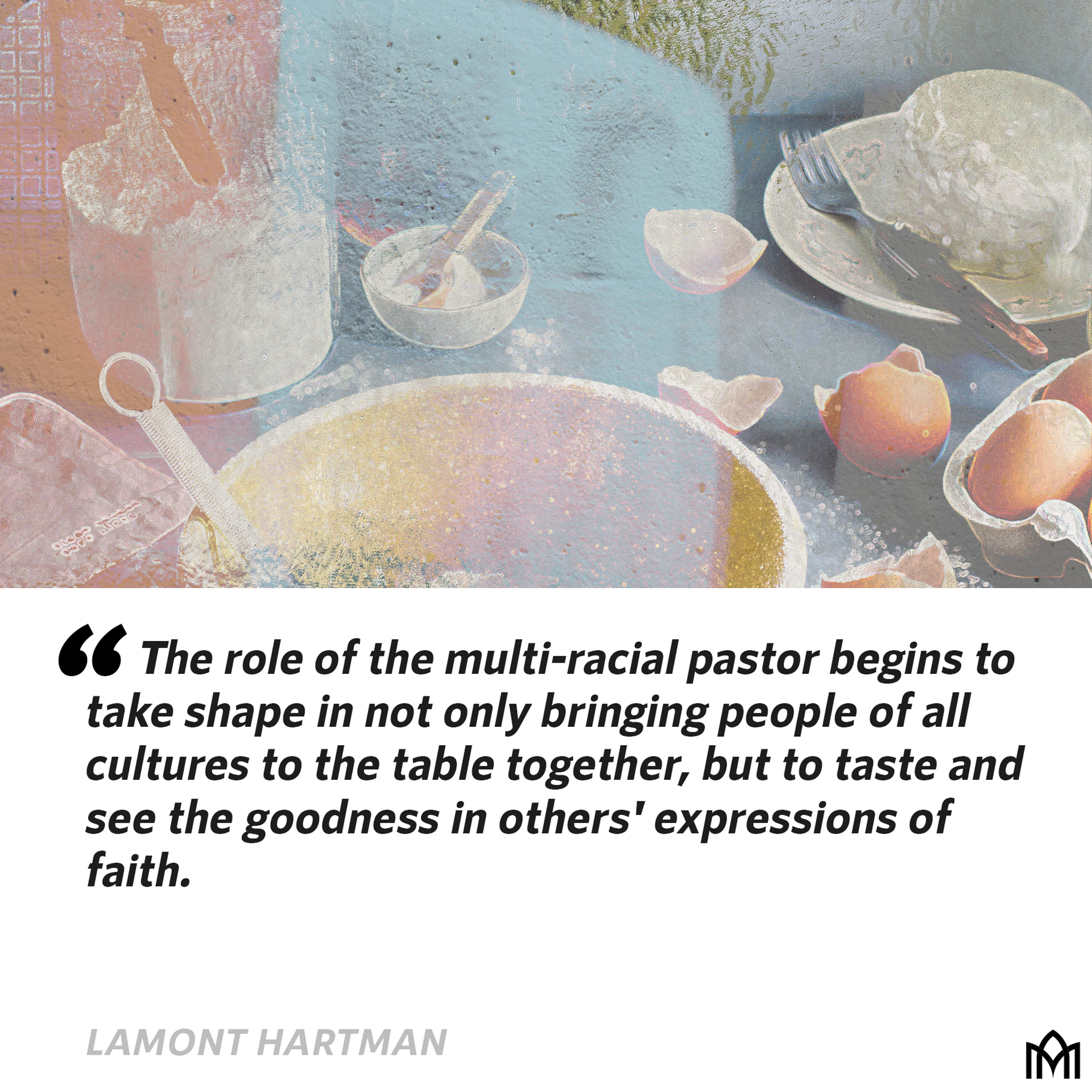My Grandmothers’ Stuffing Recipes Can Teach Multi-Racial Congregations
“Taste and see that the Lord is good; blessed is the one who takes refuge in him.” (Psalm 34:8).
At the end of each year, I typically begin an all-water fast to seek guidance and wisdom from God. A few years ago, I needed wisdom on helping my multi-racial congregation to engage cross-culturally in celebrating our differences authentically. Fasting as a spiritual discipline hasn’t always come easily for me, so it hasn’t always been my primary spiritual practice when I needed wisdom. However, over the years, fasting has also consistently given me the spiritual insight I needed to lead myself, my family, and my multi-racial congregation throughout the year.
This all-water fast was the hardest fast I had attempted, and yet simultaneously was the most insightful in leading this congregation. Looking back, my stomach seemed to grumble every few hours, which wasn’t a sign of hunger but the intelligence of my body preparing itself to eat within my normal feeding patterns. I remember calling a wise friend during this fast who often practiced fasting as a means to draw closer to God. This friend gave me exceptional advice, reminding me that “Fasting is not about having the willpower not to eat, but the ability to find pleasure in actions that draw a person closer to Christ.” This was the insight I needed to shift my focus from food to God.
Still, getting over drinking only water with no taste was mentally challenging. During the second day of my fast, after drinking a third of my gallon of water and reading scripture, I began to daydream about stuffing, dubbed chicken and dressing, all deeply enjoyed in the Southern region of the United States. My grandmothers always made the best stuffing, usually around the Christmas holidays, and every year, I would make my rounds to their houses to eat as much as possible. You may call it gluttony, but nowadays, we call it being a foodie. Every year, I eagerly looked forward to having two Christmas dinners with the best stuffing from both grandmothers, who lived on opposite sides of the city. After salivating over their delicious fare for what seemed to be an eternity, I realized how distracted I was and decided to reopen my Bible. I opened the book of Psalms and began reading until I came to a screeching halt when my eyes glanced at Psalms 34:8, reading these words: “Taste and see that the Lord is good; blessed is the one who takes refuge in him.”
The word taste seemed to leap off the page as I re-read the passage several times. The Hebrew word for “taste” in Psalm 34:8 is “טָעַם” (ta’am). Taste can imply the physical act of tasting and experiencing food, but it also means the act of discerning something deeply. To taste God is a metaphor to encourage humanity to partake in God’s goodness, wisdom, and grace. As I pondered what it meant to taste God’s goodness, a question I could only describe as the prompting of the Spirit came to mind. What would my grandmothers have said about each other’s stuffing? The Spirit then proceeded to lead me into a deeper internal dialogue concerning multiracial churches, and our critical need to teach these churches to embrace and prefer one another over ourselves.
To taste God is a metaphor to encourage humanity to partake in God's goodness, wisdom, and grace. Share on X
I think it is important to express my ethnic background to provide context for a deeper discussion about my family identity. I am biracial; my mother is white, and my father is Black. I proudly identify as a Black man. My mother raised me with the help of both my grandparents, who each provided me with the love and care I needed to grow into the man I am today. My father was primarily absent until my early twenties, but his mother was just as active in my life. Both my grandmothers have since passed on, but I still draw from their experiences today, and I can still taste their stuffing in my heart and mind.
It’s interesting to ponder how drastically different my grandmother’s stuffing recipes were. My white grandmother’s recipe included sage, an evergreen shrub within the mint family, with refreshing notes of aroma and flavor. The flavor paired well with her turkey, which was usually placed in the center of the stuffing in a huge oven pan. To be honest, my father’s side of the family, which was Black, would have cancelled Christmas after tasting any type of herbs in their stuffing. Why? Partly, because that was not a flavor they were accustomed to, thus it was not their preference.
The Black side of my family was more accustomed to sweet and savory tastes in their holiday meals. My Black grandmother would make candied yams with sugar and cinnamon, which naturally complemented her flavorful stuffing, which was pleasantly, or should I say heavenly, salty. The difference in their recipes had much more to do with their cultural upbringing and each’s lack of exposure to other types of stuffing recipes than anything else. Both grew up in the deeply segregated South of the 20th century, being taught, whether explicitly or implicitly, to stay within their own ethnic group in all areas of life. This reality ultimately restricted them from partaking in the magnificence of other cultures, from large systemic issues, to the differences in stuffing recipes.
Nevertheless, my affectionate upbringing in both these cultures helped me to appreciate and enjoy the distinction of each without preferring one over the other. I lament that my grandmothers never, to my knowledge, sat at the same kitchen table enjoying each other’s company, nor sampled each other’s stuffing recipes. If they had, I’m sure they would have quickly realized how much they missed out on an opportunity to grow in the wisdom of another cultural perspective, and I certainly hope they would have come to appreciate the distinct approaches to make delicious stuffing.
Same dish, different expressions, all based on diverse cultural experiences.
Ironically, this same opportunity exists within the multi-racial church today: to grow in understanding one another’s diverse expressions of Christian faith, ultimately coming to enjoy different demonstrations of faith in Christ that we are unaccustomed to. Yet, much like the cultural segregation present in the South, people tend to worship within and amongst people like themselves, expressing their faith in a similar manner to how they were raised. The role of the multi-racial pastor begins to take shape in not only bringing people of all cultures to the table together, but in modeling how to taste and see the goodness in diverse expressions of faith.
The problem today is that pastors leading multiracial churches often maintain white social norms, neglecting the cultural norms of other racial groups within their congregations. The neglect may be unintentional, but it still hinders others from seeing and appreciating the various expressions of faith stemming from other cultural perspectives within the church. Examples of diverse expressions of faith within a worship service are things such as demonstrative praise dancing, call and response between the preacher and the congregation, and other outwardly emotive traits typical of Black and Brown cultures. These expressions of faith are no different from my grandmothers stuffing recipes in that they are the same dish, largely derived from the same elements, but simultaneously distinct by the nature of who prepared the dish.
Our work as pastors of multi-racial churches is to consistently wonder, how was my grandmother’s stuffing made?
The role of the multi-racial pastor begins to take shape in not only bringing people of all cultures to the table together, but to taste and see the goodness in others' expressions of faith. Share on X
///
Here are two core insights on for pastors leading multi-racial churches that I have learned over the years:
- Firstly, pastors leading multi-racial churches must grow to appreciate cultural distinction within the Body of Christ before teaching others to do the same. This appreciation must be authentic in order to be transformative. For instance, in keeping with the theme of food, a pastor can’t visit the South and then decide to try soul food by ordering Uber Eats to his or her hotel. The more authentic way would be driving to the neighborhood where the best soul food restaurants are located and dining in in order to capture the full essence of the experience. Thus, seeking to understand the context of the Chef, such as the ambience of the restaurant, the staff supporting the Chef, the patrons of the restaurant, and the wider community the chef serves. All of these things can help understand the why behind the what and perhaps come to a place of appreciation.
- Secondly, pastors of multi-racial churches must also be intentional in teaching others to see the value of sharing to the same table for cross-cultural fellowship. Biblically, the table metaphor can be understood as a symbol of care and generosity. We see this in the Book of 2 Kings 4:10, where the Bible talks of the Shunammite woman who expresses welcome by saying, “Let’s make a small room on the roof and put in it a bed and a table, a chair and a lamp for him. Then he can stay there whenever he comes to us.” This particular passage presents table fellowship and its symbolic nature of care and generosity, while also demonstrating to multiracial church leaders how it should be intentionally accomplished.
We understand that the Shunammite woman lacked in possessions, and yet we read she still prepared a table for the prophet Elisha as a sign of generosity to the people of God. In addition, the preparation of the table was an indication that Elisha was welcome not only to eat, but also to lie his head in her home. She welcomed the prophet, with all her own cultural mistrust, into her home. Bearing this in mind as well: She had to go an extra mile to make the upper chamber welcome for Elisha, which suggests that there was an intentional level of care and commitment above and beyond typical cultural hospitality that she displayed.
Many of our congregants come to worship services with preconceived notions of how they should express ourselves in worship. However, if we teach them to be more like the Shunammite woman, setting their cultural preferences aside and welcoming other expressions with open arms, we will experience the beauty of diverse expressions of faith within our multicultural churches.
///
Pastors leading multi-racial churches must grow to appreciate cultural distinction within the Body before teaching others to do the same, intentionally teaching others to value sharing the same table for cross-cultural fellowship. Share on X




